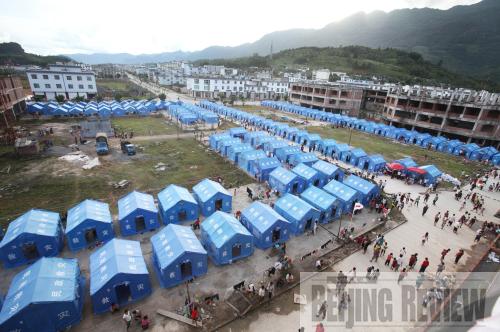|
 |
|
CHINA'S HELP: The local government puts up tents as temporary settlements in Nansan Town, Yunnan Province, for border inhabitants suffering from armed clashes in Kokang on August 30. Kokang, a Myanmar special region along the China-Myanmar border, is behind the hills (YI MING) |
Kokang, a small region of Myanmar along its frontier with China, has become a hot spot. Clashes between Myanmar government troops and local ethnic forces there have uprooted tens of thousands of people, forcing them to flee into China's Yunnan Province. China has since offered humanitarian aid to the displaced border inhabitants.
Armed conflicts began on August 27 with several battles taking place in Kokang, according to Xinhua News Agency. The tense situation originated from a check by Myanmar police on a gun-repair factory in Kokang on suspicion of drug production on August 8. The confrontation caused panic among local people and triggered an exodus of border inhabitants into the neighboring Yunnan Province's Nansan area, according to Xinhua.
Some 37,000 border inhabitants, including both Burmese and Chinese, had so far fled into China, said Meng Sutie, Police Chief of Yunnan Province, at a press conference on August 30. Some 13,000, mostly Burmese, accepted the Chinese Government's help and were relocated to temporary settlements in Nansan. Meanwhile, other Burmese opted to stay with their Chinese relatives, while Chinese citizens returned to their original homes.
As part of a humanitarian package, the Yunnan Provincial Government has allocated 10 million yuan (about $1.46 million) for supplies like tents, food, drinking water and medicine, Meng said.
In addition, local Chinese authorities increased security alert levels and made other preparations in the event of any cross-border violence. Nearby Chinese residents were also tasked with cooperating with officials to maintain normal order to keep the region stable.
On the other hand, China has not issued an order prohibiting tourists from visiting Nansan—so confident are officials that the situation remains under control. Nonetheless, Meng still recommended that potential visitors to the border area hold off until the situation fully stabilizes.
As the situation calmed down, Myanmar border inhabitants had begun to return home, he said.
By the end of August, the conflict claimed the lives of 26 soldiers and police officers, while leaving 47 others injured, according to an announcement of the Myanmar Government. Eight Kokang ethnic army soldiers were killed, it said.
One Chinese citizen died and two others were injured after three mortar rounds landed in Chinese territory, Meng said. Inside Myanmar, the fighting killed one Chinese and injured 13 others in Kokang, too. Beijing has expressed deep concerns through its diplomatic channels. But Myanmar had apologized for the Chinese casualties, while noting China's extensive humanitarian efforts.
Chinese Foreign Ministry spokeswoman Jiang Yu expressed hope that Myanmar could resolve its domestic issues, while safeguarding the stability of its border with China.
China has also required Myanmar to extend full protection to Chinese citizens in terms of personal safety, as well as property and legal rights, Jiang said.
China and Myanmar share a traditional friendship, he said, along with a common desire to promote bilateral cooperation—one that has never wavered.
The clashes might create influence to bilateral relationship and local cooperation for a period of time, he said. But China believes the negative fallout will fade over time as bilateral ties continue to deepen, he added.
Kokang, or Shan State Special Region 1 of Myanmar, is located in the northeast of the country and borders China's Yunnan Province. It has a population of about 150,000. Local Kokang ethnic armed forces agreed to a ceasefire with the Myanmar Government in March 1989, but were allowed to retain arms and establish a special region, conditionally enjoying self-administration.
(Source: Xinhua News Agency) | 